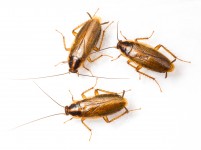Whether you’ve seen them or not, it’s the time of year the icky little critters we call Gisborne, Native Bush, American and German Cockroaches start finding their way into homes, hide in dark small spaces and breed as the weather is getting warmer. Cockroaches don’t like to be seen and only usually come out at night, so you are unlikely to see them unless you are dealing with a large infestation or go hunting in the dark for them. The way you treat your property will also depend on the type of species that are in your home, we discuss this more below.
We recommend earlier in the summer to barrier spray windows and curtains (don’t forget to spray behind curtains) using Hawkeye Flea, Ant and Roach Spray (FAR SPRAY). This will help to stop the roaches entering the home from outside. If they are already inside follow our treatment directions at the bottom of this blog.
There are many places’ roaches will hide you would never even think to look, these include (but not only limited to):
In the cracks between your sink and bench
Photo frames, in and behind. Including any frames or pictures hung on walls
Hinges on all doors
Washing machine motors
Inside microwave
Behind dishwasher, fridge – all appliances that have dark spaces behind them
Power boards
Hot water cupboards
Small cracks and crevices around the home
Other signs to look out for when there is an infestation are; roach droppings that can resemble coffee grounds, a distinctive odour, and old roach skins as they shed through metamorphosis. Adult cockroaches and their eggs – adults may be seen around pantry areas especially at night-time. Oval-shaped egg cases can also be seen glued in pantry, behind furniture or in other hidden locations, such as the spaces between books, under the sink etc.
How to treat:
Germans and Americans:
Smaller infestations will be fine using one of two products, either Hawkeye FAR Spray or using Hawkeye Cockroach Bait . You need to bear in mind, especially with Germans, if you see one there will be many more in the home. Americans are a lot slower breeding, so it is important you know exactly what species you are treating.
Medium to heavy infestations we recommend using a dual approach of products you would spray the FAR Spray around the areas we recommend and have the Cockroach Bait anywhere the roaches may hangout – you want to put the Cockroach Bait out everywhere possible and not be limited to placement.

German Cockroach – Blattella Germanica
GISBORNE COCKROACH - DRYMAPLANETA SEMIVITTA
American Cockroach – Periplaneta Americana
These types of roaches are typically what you see is what you have. They still have all the same behaviours as the other species, but they don’t tend to breed as much and only start coming inside so what you usually see is all you will have in your house.
To treat Gisborne and Native Bush Roaches we recommend setting bait up where they have been seen. If you have lots of these species in a certain area, you can also spray these areas they are hanging out. It is unlikely you will have a massive infestation with either of these species unless they have been in the home and untreated for many years. Native Bush Roaches are common in Auckland and warmer areas of the country so it would be worthwhile spraying our FAR Spray as a preventative earlier in the summer before they move in from outside.
Native Bush Cockroach
You can treat roaches externally if you notice them around your home but not inside. For external treatment we recommend using our Hawkeye Ant Spray. This product has additives to it to make it rain fast and has UV protectant so you can get about 6months protection from one treatment. It has the same active ingredient as our FAR Spray so will do the same job and treat roaches effectively.
If you don’t know what species, you have inside or around your home please contact us and our awesome Entomologist Meena will get in touch to help!
Health Risks Associated with Cockroaches:
Cockroaches are filthy pests. They can eat a range of foods, from faecal matter to fresh food intended for people to eat. American and German cockroaches can transmit disease that make us really unwell Cockroaches in general have been reported to spread at least 33 kinds of bacteria, including E. coli and Salmonella, as well as six kinds of parasitic worms and at least seven other kinds of human pathogens. They pick up germs on the spines of their legs and body as they crawl through decaying matter or sewage, and then transfer the germs onto food or cooking surfaces. The saliva, urine and faecal droppings from American cockroaches contain allergen proteins known to elicit allergic reactions and asthma attacks. As such, cockroaches are a common trigger of year-round allergy and asthma symptoms, especially in children.The Gisborne cockroach is generally a lot more harmless. Unlike German or American cockroaches, it does not spread disease, nor can it fly. It typically doesn’t invade food supplies, unless they’re decaying.
